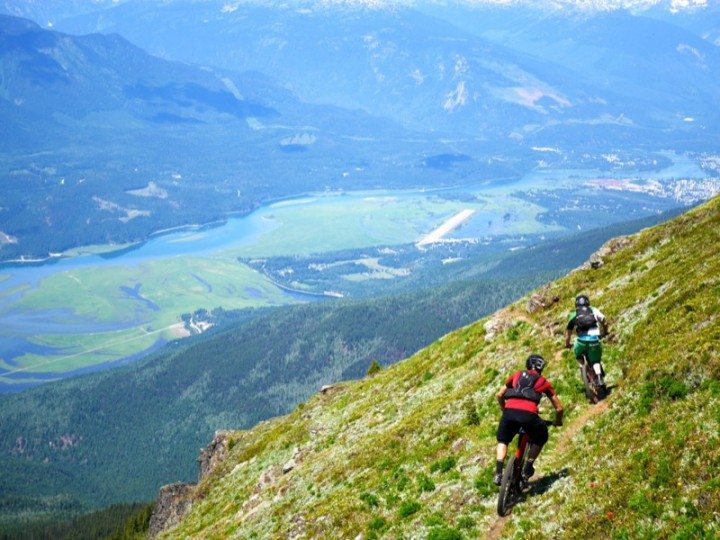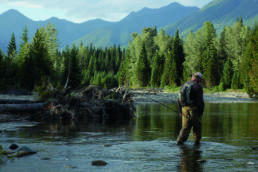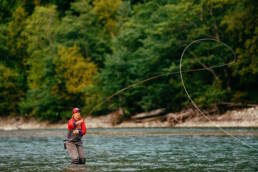Selkirk-Tangiers has come up with a long-line rack solution for heli-biking. We sent our editor to try it. Turns out the pampered life ain’t so bad at all.
Leonardo da Vinci sketched the first helicopter design in the late 1400s. Four hundred years later, Baron Karl von Drais of Germany invented the Dandy Horse, the precursor to the modern-day bicycle. Then, in July 2015, a Revelstoke-based company threw the two vehicles together and added heli-biking to its repertoire. Selkirk-Tangiers has spent almost 40 years taking people heli-skiing and boarding in the West Kootenay, but this month marks its first foray into summer offerings: from July to September the company has access to a 50,000-acre tenure—its winter tenure is over 500,000—in which to guide its new heli-biking excursions.
Air-lifting bicycles to the top of a mountain via helicopter has been around for years, but it usually involves tossing bikes into a heap, lashing them together and then longlining them to the summit. Once you reach the top, you then replace all the bike parts that broke mid-flight. Selkirk-Tangiers has successfully avoided that carnage by designing a rack that locks eight bikes into place and ensures they don’t smash against one another when connected to a longline. I was lucky enough to witness the first test of the system during the company’s inaugural run to the peak of Mount Cartier and I’m happy to report it was awesome.
The 10-minute ride in the helicopter definitely beats the seven-hour hike-and-bike up, not just for its efficiency but because flying over the Columbia River, sandwiched between mountain ranges, offers dramatic views: white-capped peaks tower above fecund valleys, while wisps of cirrus clouds are mirrored in the steel-blue water below. You become a gnat navigating an Emily Carr painting. Aside from the dramatic scenery, I also enjoyed watching our pilot maneuver the chopper, gently placing a rack filled with $3,000 bikes on top of a 2,600-metre mountain.
Downhill rider Devin Knopf captured the moment best when he raised his arms and yelled, “That was the coolest thing I’ve ever seen!” as the helicopter banked away from us into the bluebird sky. (All that was missing was some high-octane music courtesy of Freeride Entertainment.) As promised, our bikes were in mint condition, so after snapping photos of the 360-degree views, we hit the pedals and started the 15-kilometre ride down.
“[We are] currently limited to drops on Cartier, which is a more downhill-inclined trail,” says Emma Mains, the guest services coordinator at Selkirk-Tangiers. “We have plans for about 50 kilometres of alpine cross-country trails in the Ghost Peak area of our tenure (directly behind Mount Cartier and Mount Mackenzie) in the near future, with hopes to possibly begin work on infrastructure for these trails this fall.”
She goes on to say the cost of a day’s worth of heli-biking is $345 per person and that includes the helicopter drop, lunch, return shuttle and your own personal guide. This last factor is key, because even if you know the area and trails, having someone nearby who’s trained for emergencies and who has a radio link to the company’s base at Revelstoke Mountain Resort takes most of the stress out of the endeavour. Plus, the company has a Bell 206 JetRanger helicopter on retainer for the summer, so you can show up by 9:30 a.m. any day of the week and be assured a lift.
Before the launch of its summer program, Selkirk-Tangiers put some effort into improving the Mount Cartier trail so you can descend the entire mountain and rarely get off your bike. We encountered everything from tight switchbacks near the summit and fun run-outs through alpine meadows to fast and flowy forested singletrack and a few technical, rocky sections. Other than Knopf, the rest of us had all-mountain bikes with a minimum of five inches of travel front and back—and we had a blast.
Among our group were a few professional photographers, including Bruno Long and Ian Houghton, so it took us over four hours to descend with all the photo setups, scenic viewpoint stops and a 20-minute lunch break at McKay Creek. By the time we hit pavement, though, my forearms and brake pads were cooked. We loaded our bikes onto a trailer and rode in the company van back to the Selkirk-Tangiers office. During the 10-minute return trip, Knopf piped up and asked, “What time is it?” to which Bruno responded, “The time of your life, dude.” Truer words have never been spoken.
[foogallery id=”10825″]
Vince Hempsall
Vince Hempsall lives in the beautiful mountain town of Nelson, British Columbia, where he spends his time rock climbing, backcountry skiing and mountain biking (when not working). He is the editor of Kootenay Mountain Culture Magazine and online editor for the Mountain Culture Group.
Related Stories
Simple Fly Fishing
VENTURA, Calif. (March 31, 2014) — Patagonia, Inc., the outdoor apparel company, today launched its Simple Fly Fishing…
Sweetgrass Lets Freak Flag Fly With New Kootenay Inspired Film
They are one of the most talented production houses in winter sports today. A fusion of young American filmakers who…
Fly-Fishing in the East Kootenays
After a couple of bad breaks, an upstart East Kootenay angler learns the river's ropes and finds revival in the…
How To Become a Fly-Fishing Influencer: April Vokey
Empowerment and steelhead on the Bulkley River. Fly-fishing guide April Vokey casts away. By Amanda Follett Hosgood.…
Kootenay Sufferfest
What tastes so good in there? We are stoked to announce that Kaslo Sufferfest kicks off this weekend, with record…










